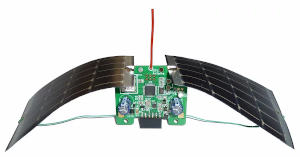Learning About Pico Balloons
Oct 5, 2020
At the AREX LAX meeting last Saturday, Brian N6CVO gave a very
interesting presentation on "Pico Balloons," small balloons with payloads so small that the entire vehicle–balloon,
electronics, and antenna–is less than 20 grams. I was attending the CVARC General Class
Session, but I watched the presentation later, thanks to David Goldenberg
W0DHG, who posted it on the HamRadioNow YouTube
channel. I was interested to learn:
- These are "super pressure" balloons, meaning the balloon is filled with lifting gas and sealed before launch.
The balloon expands as it ascends until it reaches an equilibrium and maintains a relatively consistent altitude. The
amount of gas is calculated to provide enough lift at ground level to ascend relatively quickly, so the balloon isn't
damaged by low level weather, and then maintain a chosen altitude of 30 to 43 thousand feet.
- The preferred lifting gas is hydrogen, because the diatomic hydrogen molecule is larger than the helium molecule, for
less leakage. Also, pure hydrogen is commonly available, while commercially available helium is required to be
adulterated with air or oxygen, for safety, since it is used by the public and so presents an inhalation risk. A
relatively small amount of hydrogen is needed to launch a pico balloon.
- Aviation regulations do not require clearance or even notification for balloons less than 4 pounds. A pico balloon is
so small that an aircraft turbine engine would just ingest it without noticing.
- The electronics are solar powered. One or two small solar panels provide enough power to charge supercapacitors,
which in turn power the radio and microcontroller for a burst transmission.
- A number of broadcast protocols are used. APRS, of course. But also
WSPR, a weak signal FSK protocol that encodes 162 bits
into a 2-minute frame that can be received thousands of miles away. WSPR allows more tracking over oceans and other remote
areas, albeit at a lower resolution than APRS, because HAMs around the world monitor WSPR and share data via
WSPRnet.
- Pico balloons are almost never recovered. They are just too small and don't have any ability to ping after coming to
earth.
 There are lots of tracking modules available, such as the ZachTek WSPR-TX Pico
Transmitter, and lots of DIY possibilities using open
source software.
There are lots of tracking modules available, such as the ZachTek WSPR-TX Pico
Transmitter, and lots of DIY possibilities using open
source software.
Pico Ballonists use dime-store balloons or more expensive scientific balloons like the
SBS-13.
At the time of his presentation, Brian's N6CVO-13 balloon was still aloft after 86 days and 4.5 circumnavigations. He
polls WSPRnet and repeats the data to aprs.fi, so we can track
N6CVO-13 there.
When I wrote about the WB6TOU-11 Circumnavigation, I didn't realize pico balloonists
almost never recover their vehicles. Still, I can see they learn a lot from each flight!
![]() There are lots of tracking modules available, such as the ZachTek WSPR-TX Pico
Transmitter, and lots of DIY possibilities using open
source software.
There are lots of tracking modules available, such as the ZachTek WSPR-TX Pico
Transmitter, and lots of DIY possibilities using open
source software.